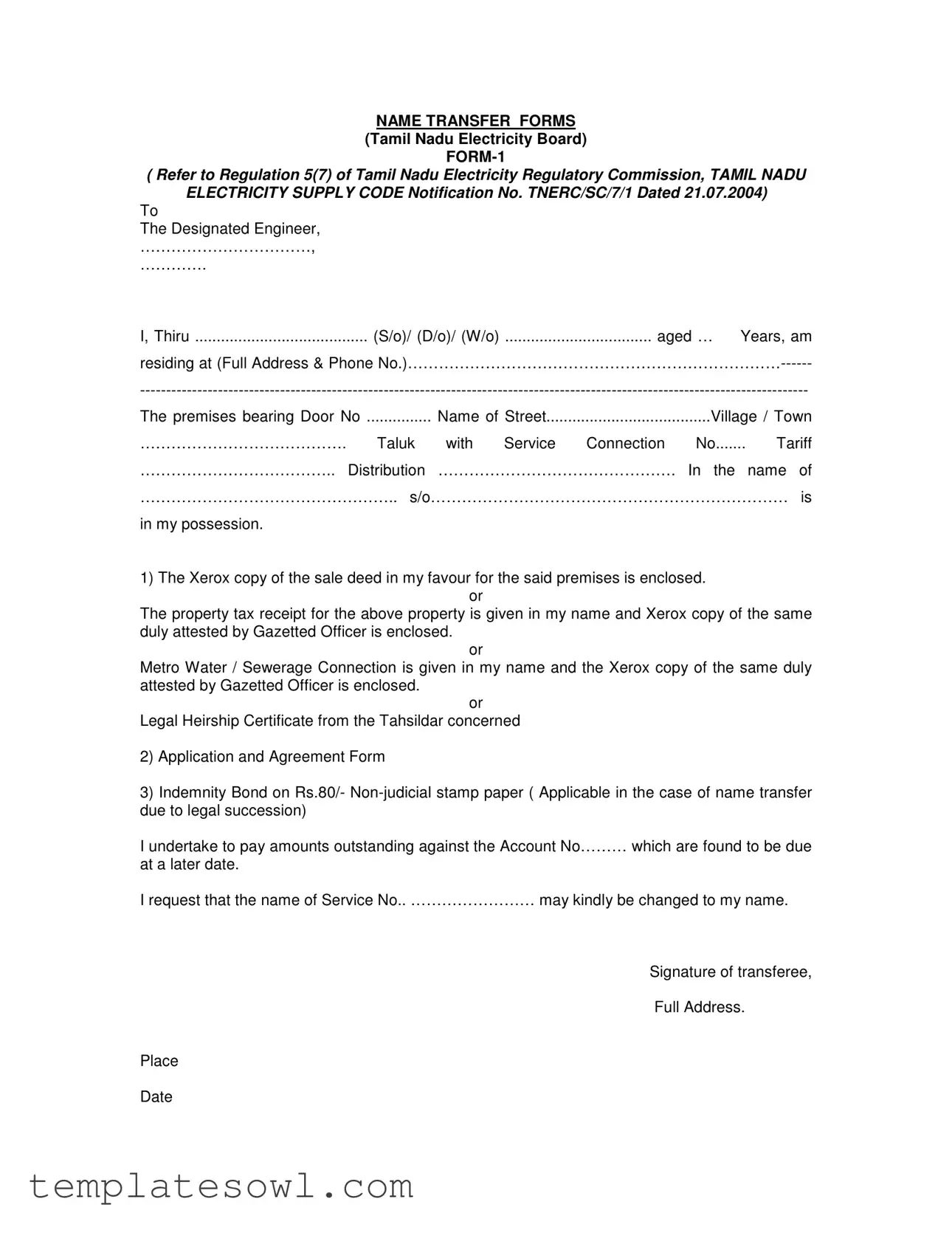NAME TRANSFER FORMS
(Tamil Nadu Electricity Board)
FORM-1
(Refer to Regulation 5(7) of Tamil Nadu Electricity Regulatory Commission, TAMIL NADU ELECTRICITY SUPPLY CODE Notification No. TNERC/SC/7/1 Dated 21.07.2004)
To
The Designated Engineer,
……………………………,
………….
I, Thiru ........................................ (S/o)/ (D/o)/ (W/o) .................................. aged … Years, am
residing at (Full Address & Phone No.)………………………………………………………………------
---------------------------------------------------------------------------------------------------------------------------------
The premises bearing Door No |
Name of Street |
Village / Town |
…………………………………. Taluk |
with Service Connection |
No |
Tariff |
……………………………….. Distribution ………………………………………. In the name of
………………………………………….. s/o…………………………………………………………… is
in my possession.
1)The Xerox copy of the sale deed in my favour for the said premises is enclosed. or
The property tax receipt for the above property is given in my name and Xerox copy of the same duly attested by Gazetted Officer is enclosed.
or
Metro Water / Sewerage Connection is given in my name and the Xerox copy of the same duly attested by Gazetted Officer is enclosed.
or
Legal Heirship Certificate from the Tahsildar concerned
2)Application and Agreement Form
3)Indemnity Bond on Rs.80/- Non-judicial stamp paper ( Applicable in the case of name transfer due to legal succession)
I undertake to pay amounts outstanding against the Account No……… which are found to be due
at a later date.
I request that the name of Service No.. …………………… may kindly be changed to my name.
Signature of transferee,
Full Address.
Place
Date
FORM-2
Name Transfer Forms
(Refer to Regulation 5(7) of Tamil Nadu Electricity Regulatory Commission, TAMIL NADU ELECTRICITY SUPPLY CODE Notification No. TNERC/SC/7/1 Dated 21.07.2004)
(To be used as a consent letter from transferor in case of sale etc.,)
To
The Designated Engineer / …………..
Address of the Licensee Engineer |
|
I |
(S/o D/o W/o) |
owner of premises bearing |
Door No |
(Name of the Street …….. Place …………………..) hereby give my consent for |
the transfer of service bearing A/c. No |
standing in my name / in the name of ……… to |
Thiru/Tmty |
S/o. D/o W/o |
..........................................since I had sold my |
house to him/her |
|
The transfer may be effected with available deposit / subject to the condition that the transferee pays the security deposit and other charges *.
Signature of transferor,
Full Address.
Place
Date
* Strike out the portion not required
FORM-3
( Refer to Regulation 5(7) of Tamil Nadu Electricity Regulatory Commission, TAMIL NADU
ELECTRICITY SUPPLY CODE Notification No. TNERC/SC/7/1 Dated 21.07.2004)
INDEMNITY BOND
|
Sub: Electricity – …….. Distribution – Transfer of Security |
|
|
Deposit and Service Connection – Premises |
|
|
No |
A/c. No |
|
I |
son of/ daughter of/ wife of Thiru../ Tmty |
do hereby |
declare that Thiru. / Tmty |
owner of the above premises has expired |
on |
and I am the legal heir to the deceased, I desire to have the security deposit |
and service connections transferred in my name. I agree to indemnify the Licensee against any losses, damages etc., arising consequent on any disputes by reason of the security deposit and service connections being transferred to me as the legal heir to the property of late Thiru.
The Licensee shall have the right to proceed against me not only in respect of movable and immovable properties belonging to me but also against me personally in regard to all liabilities past, present and future claims relating to this service connection. The above facts are certified to be correct.
SIGNATURE OF THE CONSUMER
Signed before me
Notary Public / Gazetted Officer
Station
Date
FORM-4
( Refer to Regulation 5(7) of Tamil Nadu Electricity Regulatory Commission, TAMIL NADU
ELECTRICITY SUPPLY CODE Notification No. TNERC/SC/7/1 Dated 21.07.2004)
UNDERTAKING
Whereas I/We |
S/o, D/o, W/o |
(a firm under the name and style of) |
herein after called consumer, have approached the (Name of Licensee) herein after referred to as Licensee for transfer of A / C No........................for supply at ..................................................in
my/our name and where as the Licensee after perusal of documents produced by me/us has agreed to effect transfer of account, as sought for by the consumer, this undertaking witness the following:
The consumer shall pay on demand and without demand all dues to the Licensee including such dues as may become payable as a result of revision of bills relating to the period prior to the transfer of account in his/her/their name. The commitment to pay the demands relating to the period prior to the transfer of account will include such demands omitted to be made periodically and such omission has been detected after the service has been transferred in the name of the consumer.
2.The Consumer agrees that the Licensee shall have the right to enforce disconnection of supply in the event of consumer failing to fulfill the obligation of this undertaking.
3.The consumer further agrees to indemnify the Licensee against any loss/damage or any other liability, the Licensee may suffer as a result of any dispute or disputes raised by the consumer himself/herself/themselves or by any other party with regard to this transfer of account at any time.
SIGNATURE
WITNESS WITH ADDRESS
1.
2.
